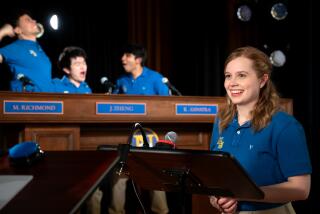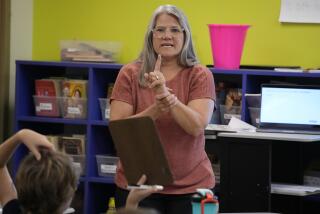Mathematics Via Video--Now That’s Entertainment! : Teaching: Instead of blaming TV for slumping test scores, use its child-enchanting technology to make abstract concepts visual.
- Share via
Reports that average college-board scores have dropped again have brought forth the usual simplistic explanation that “kids watch too much TV.” While there are problems in American education, you can’t blame all of them on TV. In fact, I’d argue that TV has a role to play in mathematics education.
Children watch TV because it opens up entirely new worlds. Like it or not, they’ll keep watching. The power of visual images to stir the deepest emotions has always been understood by artists. Television places these images in motion together with music and special effects. Its impact on the human mind is well understood by entertainers, advertisers and politicians, but not, it seems, by most educators.
Instead of blaming TV, let’s exploit this technology creatively to reveal the wonders of science and mathematics to young people. Let’s bring quality television into the classroom as a powerful visual aid to be used together with books, computers and supplementary materials.
American education in mathematics has been facing a serious crisis that existed even when college-board scores were going up. More than half of the high schools in the United States offer no advanced courses in mathematics and science, and nearly one-third of today’s science teachers are inadequately prepared. In the next decade a large fraction of existing teachers will retire, and there is virtually no prospect of replacing them with qualified teachers because of declining enrollments in teacher training programs. Consequently, most American schoolchildren are at risk of becoming scientifically illiterate citizens at a time when science and technology play an increasingly important role in life. These problems are more serious than a slight drop in college-board scores, and they can be solved by changing the ways we teach children in the classroom, especially in the early grades. All young children have natural curiosity, the prerequisite for learning mathematics. They love to solve puzzles and discover patterns. The challenge is not simply to improve arithmetic skills and test scores, but to find new ways to enhance children’s natural curiosity and show them that learning mathematics can be exciting and intellectually rewarding. When children are motivated to learn and to understand mathematics, the test scores take care of themselves. Surely the same technology that gets children excited about Ninja Turtles can also get them excited about geometry.
It’s a widespread myth that you cannot do serious mathematics or science on TV. This myth has been dispelled in part by the telecourse “The Mechanical Universe,” a one-year course in physics for college freshmen produced by Caltech and the Southern California Consortium. This series is regarded as a major breakthrough in the use of television to teach physics. A key ingredient that helped this series succeed is stunning computer animation that brought the subject to life in ways that hadn’t been seen before.
The same type of animation is used by Project MATHEMATICS!, a new series of videotapes produced by Caltech for classroom use in Grades 8 through 13. Each tape is accompanied by a workbook that encourages interaction among teacher, student and videotape. Each module provides support material to be integrated with other classroom activities.
The videotapes present mathematics in ways that cannot be done at the chalkboard or in a textbook. Words and moving images are combined with music and special effects to provide a valuable pedagogical tool to attract young students to mathematics. In one sequence, for example, animation divides a circular disk into small triangular pieces that march in time to music, forming a rectangular figure with the same area. The formula for the area of the disk is revealed visually in an entertaining way that increases understanding.
During the past two years, nearly 2 million students have been turned on to mathematics by one or more of the first four videotapes: “The Theorem of Pythagoras,” “The Story of Pi,” “Similarity” and “Polynomials.” Project MATHEMATICS! has demonstrated that a small staff--four full-time people and an equal number of part-time workers and volunteers--can make a small but significant impact on mathematics education. If the television industry, which knows how to entertain, would devote a tiny fraction of its resources and expertise to work with creative mathematicians who know how to teach, the results could have a spectacular effect on mathematics education.
More to Read
The complete guide to home viewing
Get Screen Gab for everything about the TV shows and streaming movies everyone’s talking about.
You may occasionally receive promotional content from the Los Angeles Times.






